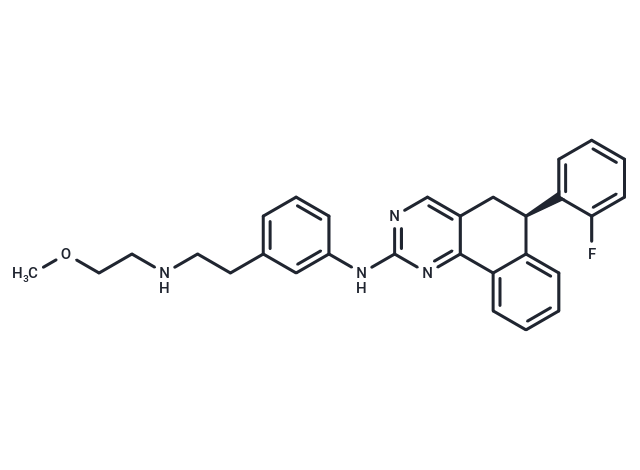Shopping Cart
- Remove All
 Your shopping cart is currently empty
Your shopping cart is currently empty

Derazantinib (ARQ-087) is a potent, ATP-competitive, orally active tyrosine kinase inhibitor with IC50 values of 4.5/1.8/4.35/3.4 nM for chondrocyte FGFR1/FGFR2/FGFR3/FGFR4, respectively.

| Pack Size | Price | Availability | Quantity |
|---|---|---|---|
| 1 mg | $48 | In Stock | |
| 5 mg | $118 | In Stock | |
| 10 mg | $172 | In Stock | |
| 25 mg | $286 | In Stock | |
| 50 mg | $423 | In Stock | |
| 100 mg | $629 | In Stock | |
| 200 mg | $895 | In Stock | |
| 1 mL x 10 mM (in DMSO) | $127 | In Stock |
| Description | Derazantinib (ARQ-087) is a potent, ATP-competitive, orally active tyrosine kinase inhibitor with IC50 values of 4.5/1.8/4.35/3.4 nM for chondrocyte FGFR1/FGFR2/FGFR3/FGFR4, respectively. |
| Targets&IC50 | FGFR3:4.5 nM, FGFR1:4.5 nM, FGFR2:1.8 nM |
| In vitro | METHODS: COS-1 cells ectopically expressing FGFR1, FGFR2, FGFR3, or FGFR4 were treated with derazantinib (ARQ-087) (0.1, 0.3, 1.1, 3.3, 10 μM, 2 hours) and stimulated with 100 pM FGF1/2/7 for 15 minutes. Total and phosphorylated FGFRs were assessed by Western blot analysis. RESULTS Derazantinib inhibited phosphorylation of FGFR1, FGFR2, FGFR3, and FGFR4 with IC50 values of <0.123 μM, 0.185 μM, 0.463 μM, and >10 μM, respectively, together with EC. [1] |
| In vivo | METHODS: Derazantinib (ARQ-087) (25, 50, 75 mg/kg) treated SNU-16 and NCI-H716 xenograft athymic mouse models; Derazantinib (50, 100, 150 mg/kg) treated Ba/F3-FGFR2 xenograft athymic mouse models Thymic mouse model; Derazantinib (75 mg/kg) treated Ba/F3-INSR xenograft athymic mouse model; both were administered orally and the in vivo anti-tumor effect of Derazantinib was evaluated. RESULTS Derazantinib showed potent tumor growth inhibition in the Ba/F3-FGFR2 model but failed to inhibit the growth of the Ba/F3-INSR model; in the SNU-16 xenograft study, 75 mg/kg and 50 mg /kg treatment achieved TGI of 83% and 69%, respectively; in the NCI-H716 human cecum model, 50 mg/kg and 75 mg/kg showed significant TGI of 68% and 96%, respectively. [1] |
| Kinase Assay | Derazantinib is titrated in DMSO utilizing a 3-fold dilution scheme and then diluted 10-fold further in deionized water for a final DMSO concentration of 10%. A volume (2.5 μL) of these dilutions or vehicle is added to each well of a reaction plate. FGFR1 or FGFR2 is added to assay buffer to each well in a volume of 17.5 μL for a final concentration of 0.50 or 0.25 nM, respectively. After a 30-minute pre-incubation period, ATP and substrate are added in assay buffer (5 μL) for final concentrations of 0-1,000 μM ATP and 80 nM biotinylated-PYK2, for a final reaction volume of 25 μL. The plates are incubated for 60 minutes at room temperature and then stopped in the dark by the addition of 10 μL stop/detection mixture prepared in assay buffer containing EDTA [1]. |
| Cell Research | Cells are seeded at 3000-5000 cells per well with 130 μL media in 96-well tissue culture-treated plates. The cells are incubated overnight and subsequently treated with 3-fold serial dilutions of Derazantinib starting at 100 μM. The cells are returned to a 37°C humidified incubator for 72 hours. Cell proliferation is measured using the MTS assay [1]. |
| Animal Research | Female NCr nu/nu mice (SNU-16) or CB17 SCID mice (NCI-H716) with well established (400 mg) subcutaneous tumors are given a single oral dose of Derazantinib or vehicle control. Plasma and tumor samples are collected 4 hours post single dose. Derazantinib is administered orally. The dosing volume for all groups is 10 mL/kg or 0.1 mL/10 g body weight [1]. |
| Alias | ARQ-087 |
| Molecular Weight | 468.57 |
| Formula | C29H29FN4O |
| Cas No. | 1234356-69-4 |
| Smiles | COCCNCCc1cccc(Nc2ncc3C[C@@H](c4ccccc4F)c4ccccc4-c3n2)c1 |
| Relative Density. | 1.218 g/cm3 (Predicted) |
| Storage | Powder: -20°C for 3 years | In solvent: -80°C for 1 year | Shipping with blue ice. | |||||||||||||||||||||||||||||||||||
| Solubility Information | DMSO: 98 mg/mL (209.15 mM), Sonication is recommended. | |||||||||||||||||||||||||||||||||||
Solution Preparation Table | ||||||||||||||||||||||||||||||||||||
DMSO
| ||||||||||||||||||||||||||||||||||||

Copyright © 2015-2025 TargetMol Chemicals Inc. All Rights Reserved.